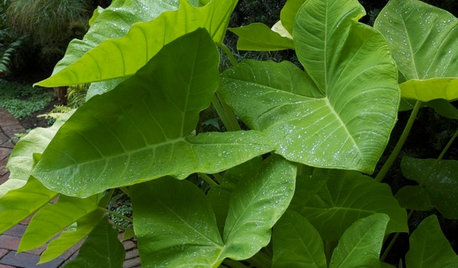Elephant Ears For Food
theoj
11 years ago
Related Stories

PRODUCT PICKSGuest Picks: Elephants On Parade
Add any one of these elephants to a room for an extra dose of exotic style
Full Story
KITCHEN DESIGNKitchen Counters: Try an Integrated Cutting Board for Easy Food Prep
Keep knife marks in their place and make dicing and slicing more convenient with an integrated butcher block or cutting board
Full Story
COLORPick-a-Paint Help: How to Quit Procrastinating on Color Choice
If you're up to your ears in paint chips but no further to pinning down a hue, our new 3-part series is for you
Full Story
GREEN BUILDINGThe Big Freeze: Inventors Break New Ground to Keep Things Cool
Old-fashioned fridges can be energy guzzlers, but there are more eco-friendly ways of keeping food fresh, as these global innovations show
Full Story
GARDENING FOR BUTTERFLIESGardening for the Bees, and Why It’s a Good Thing
When you discover how hard bees work for our food supply, you may never garden without them in mind again
Full Story
LIFEHow to Prepare for and Live With a Power Outage
When electricity loss puts food, water and heat in jeopardy, don't be in the dark about how to stay as safe and comfortable as possible
Full Story
ARCHITECTURE4 Things a Hurricane Teaches You About Good Design
When the power goes out, a home's design can be as important as packaged food and a hand-crank radio. See how from a firsthand account
Full Story
TROPICAL STYLEEasy Decorating: Turn Over a New, Tropical Leaf
Toss a palm frond in a vase or gather a whole bouquet — fresh or preserved tropical leaves bring on the exotic with almost no effort
Full Story
GARDENING GUIDES7 Tropical Wonders of the Plant World
Go for high impact with the spectacular foliage, over-the-top florals or iconic profiles of these hand-picked tropical favorites
Full Story
KITCHEN MAKEOVERSKitchen of the Week: Rich Materials, Better Flow and a Garden View
Adding an island and bumping out a bay window improve this kitchen’s layout and outdoor connection
Full Story








writersblock (9b/10a)
theojOriginal Author
Related Professionals
Beavercreek Landscape Architects & Landscape Designers · Graham Landscape Architects & Landscape Designers · Saint Louis Park Landscape Architects & Landscape Designers · El Sobrante Landscape Contractors · Fishers Landscape Contractors · River Ridge Landscape Contractors · West Covina Landscape Contractors · Ashland Decks, Patios & Outdoor Enclosures · Hialeah Decks, Patios & Outdoor Enclosures · Methuen Decks, Patios & Outdoor Enclosures · Eustis Decks, Patios & Outdoor Enclosures · Fairfax Siding & Exteriors · Lombard Siding & Exteriors · Palatine Siding & Exteriors · North Reading Siding & Exteriorsgaryfla_gw
tropicbreezent
Tiffany, purpleinopp Z8b Opp, AL